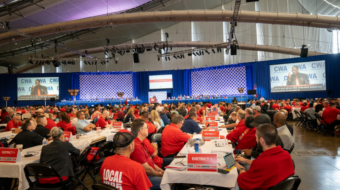A new study shows that of the $1.05 billion of stimulus funds handed out for clean energy grants since Sept. 1, 84 percent – $849 million – has gone to foreign wind companies. One firm alone, Spanish utility company Iberdrola S.A., has collected $545 million through its U.S. subsidiary.
Although the foreign wind companies are investing in U.S. operations, the turbines that are at the heart of these operations are being manufactured overseas. So, unions and others concerned about the economy are asking, what about the badly needed American jobs the stimulus is supposed to help create? They are demanding stronger federal action to create clean energy manufacturing jobs here in the U.S.
The study, by Russ Choma with the Investigative Reporting Workshop at American University, was highlighted on the AFL-CIO’s blog this week.
In addition to the Spanish company Iberdrola, Portuguese, Japanese, German and British utility companies have received clean energy stimulus grants via their U.S. subsidiaries.
And a consortium of U.S. and Chinese companies is seeking $450 million in economic recovery funds to build a $1.5 billion wind farm in Texas. The wind farm will create 30 permanent jobs in the U.S., but 2,000 jobs in China.
The consortium says it would import 240 Chinese turbines to Texas, where 300 temporary construction jobs would be created and another 30 permanent jobs established.
That has Steelworkers President Leo Gerard up in arms.
“It’s bad enough that we’ve off-shored our factories and technology and jobs over the past 20 years,” he wrote on the USW web site Nov. 6. “We’re not off-shoring our stimulus cash too. In fact, we’re tired of serving as the schoolyard wimp of the world. We need our own industrial policy so we can stand up and compete in the world market manufacturing the likes of wind turbines. And we need it now.”
“If the United States put half the effort into supporting its renewable energy industry that China does, there would be no way this consortium building windmills in Texas would be looking overseas for turbines,” Gerard said.
As Gerard notes, China is making huge government investments in green energy and is way ahead of the U.S. in wind energy.
It’s not just China, of course. One reason why foreign companies are applying for and getting so much of the clean energy money is that the U.S. lags far behind others on government investment in this area, Choma writes.
“European governments have awarded permanent tax breaks and large subsidies to wind energy companies and poured vast sums into research and technology,” he points out.
Meanwhile, Republicans and their oil industry friends are furiously trying to block clean energy legislation now before the Senate that would boost domestic clean energy initiatives. Proposals being debated would require that 15 or 20 percent of the nation’s energy come from renewable sources within 10 years. But Choma’s report points out that “Denmark, by comparison, has already achieved that goal – and in the process became the most dominant wind turbine manufacturer in the world.”
Building the modern, sophisticated turbines is where the bulk of the wind energy jobs are. Choma cites a study by the Renewable Energy Policy Project. It estimates that every 1,000 megawatts of wind energy that is developed creates 4,300 jobs. Of those, 600 are for operation and maintenance of the wind farms, 700 for installation of new turbines, and a whopping 3,000 for manufacturing.
So it’s turbine manufacturing that “matters most economically,” he says.
The 11 wind farms that received clean energy stimulus grants installed 982 turbines – and 695 of them were manufactured by a foreign company, presumably overseas.
A spokesman for Vestas Americas , a unit of a Danish company, estimates the company has invested $1 billion in developing U.S. facilities over the past two years. This includes opening several plants in Colorado to build wind blades and plans to open more plants that will manufacture towers and engine components.
By the end of 2010, the company hopes to employ 4,000 people in the U.S. in sales, service and manufacturing.
Iberdrola’s American subsidiary, Iberdrola Renewables, employs 800 people in the U.S. The company said it expects to receive another $30 million from the U.S. government, and said that money will be reinvested in the U.S.
But other manufacturers, including American firms, are building parts factories overseas in countries where labor costs are cheaper.
GE has three plants in China producing turbine components, and the company recently began work on a wind turbine components factory in Vietnam that will employ 500 local workers and export 10,000 tons of components to GE Energy assembly plants around the world.
The Campaign for America’s Future has an online petition to Energy Secretary Steven Chu, urging him to “reject any request for stimulus money unless the high‐value components, including the wind turbines, are manufactured in the United States.”
Photo: Workers build wind turbine blades a Spanish-owned Gamesa factory in Ebensburg, Pa. Teresa Albano/PW










